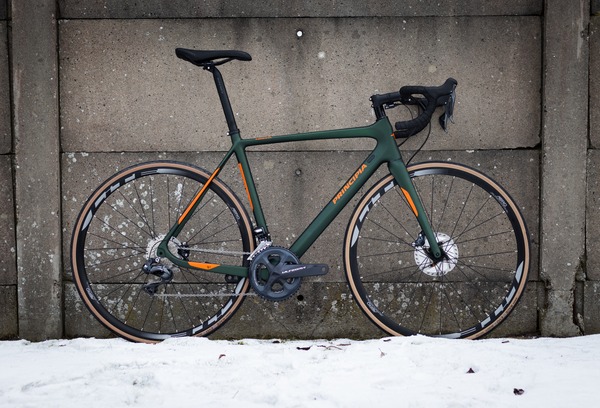If you have a cyclocross bike or are interested in one, you may be wondering what surfaces you can use them on…
Can you ride a cyclocross bike on trails?
Actually, yes. Cyclocross bikes are quite a pleasant ride when you are traversing trails. That’s because these bikes have a shorter top tube than mountain bikes and even road bikes, as well.
As a result, the cyclist is seated in an optimal upright position.
While you might not notice is at first, if you are used to riding trails on a mountain bike, then you’ll notice a difference in longer riding sessions. The geometry of the cyclocross bike makes for superior comfort on the trails for longer periods.
Can a cyclocross bike be used as a mountain bike?

You can use it as a mountain bike, but keep in mind that it’s not going to be as good at certain functions if you do. As far as riding trails and negotiating difficult terrain, a cyclocross will handle well, but mountain bikes have enhanced durability and extra weight that can make more precarious riding a smoother experience.
That said, for light off-roading and even the occasional ‘rough and tumble’ run, a cyclocross is certainly up to the task if that’s what you’d like it to do.
Can I use a cyclocross bike as a road bike?
Yes, you can use a cyclocross as a road bike, although you might consider replacing the stock wheelset for something more specialized. Even if you don’t do this, however, cyclocross bikes will still ride nicely on a road.
They are designed to function well in several varying terrains, such as mud, sand, trails, grass, and yes – roads. You won’t get the same speed as a standard road bike, as road bikes are rated around 35 mph on average, but at 29-31 mph for the cyclocross, it certainly won’t be an enormous difference.
What are cyclocross bikes best for?
Cyclocross bikes are designed for racing across wild and variable terrain. For instance, they are great for negotiating mud, grass, sand, rocks, and even patches of snow. The geometry of the design helps for more aggressive riding and control, while also ensuring more comfort than many other off-roading bike designs.
While they could be driven on the road, as well, cyclocross bikes shine when off-roading, where the terrain can be a little unpredictable and there are a lot of environmental variables to negotiate during your ride.
Can a cyclocross bike be used for touring?
Unless you have large feet, then you can use a cyclocross bike for touring if you like and you won’t notice a whole lot of difference. They are slower than road bikes, having a 29 – 31 mph speed range compared to the road bike’s 35 mph average, but otherwise, they are quite well-suited for the task.
If you have larger feet, then the chainstay length may be a bit of an issue, but otherwise, a cyclocross is well suited for touring if you would like to give it a go.
Can cyclocross go off-road?
Yes, cyclocross bikes can certainly go off-road and they are designed with this in mind. Cyclocross bikes are made for steep slopes, muddy patches, and sand pits, and can even give the snow a run for its money.
The frame design puts the rider in a position to ride aggressively and to have fairly granular control in some of the roughest conditions.
Should I buy a cyclocross or gravel bike?
That depends on your needs. If you like to spend a lot of time on rough trails, then the gravel bike is likely going to be better suited for this. That’s because you have a better seating position and a shorter handlebar reach, which you will notice if you spend extended periods riding.
So, if you are intending to make lots of long runs in nature, the gravel bike will be more comfortable, although for ‘short and sweet’ roading the cyclocross will give you a little better control with a cost of comfort for those times when the ride is going to be an hour or longer.
Are cyclocross bikes good for winter?

Yes, cyclocross bikes are good for winter, although you’ll likely want to invest in some winter tires that you can throw on the bike when it starts getting chilly out. The standard wide cyclocross tires are great for mud, but if you optimize them for winter then you’ll save on wear and tear and have a much better ride.
Even if you don’t, you’ll still have a good time – Cyclocross is designed for variable terrain — but if you invest in more selective tires that you can swap out then you’ll always have a backup tire set and you’ll notice the difference in the quality of your rides.
Is a cyclocross bike faster than a mountain bike?
It’s going to depend on the terrain. Mountain bikes will be faster on downhill runs and have a little more power for negotiating steeper slopes, but the cyclocross has a wider range of negotiable terrains.
Cyclocross bikes are great for things such as mud, gravel, snow, and sand, but they are not as heavy and durable as mountain bikes, so you are going to have noticeably less power and control if you are used to riding MTBs.
What is the point of cyclocross?
Tour de France riders are responsible for the cyclocross design and it was meant to keep them in shape in between competition times.
By creating a design that was optimal for fall and winter runs, the result was a bike that could negotiate a wide range of terrains and arguably, also cut out any potential ‘excuses’ for not staying in shape.
Thus, the cyclocross was created, and while the point was to essentially make an ‘all-terrain’ exercise bike, the result was simply so much fun that the cyclocross has developed a loyal following all its own.
Well outside of the Tour de France motivations that originally drove the development of the design!